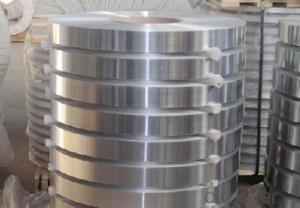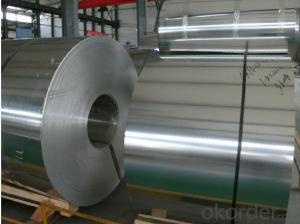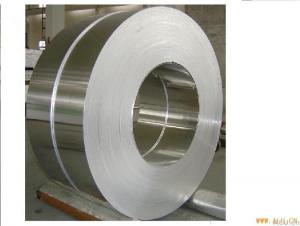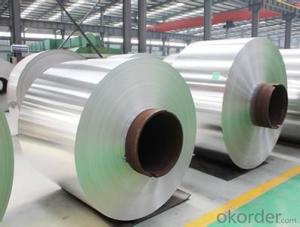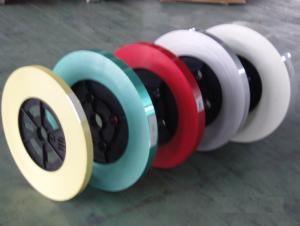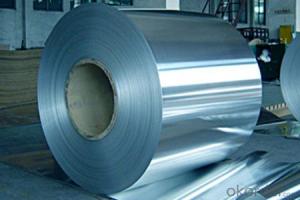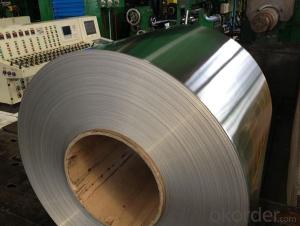HVAC Coating Series 1,3,5 Aluminum Coil Mill Finished
- Loading Port:
- Shanghai
- Payment Terms:
- TT or LC
- Min Order Qty:
- 5 m.t.
- Supply Capability:
- 9000 m.t./month
OKorder Service Pledge
OKorder Financial Service
You Might Also Like
Aluminium is a relatively soft, durable, lightweight, ductile and malleablemetal with appearance ranging from silvery to dull gray, depending on the surface roughness. It is nonmagnetic and does not easily ignite. A fresh film of aluminium serves as a good reflector (approximately 92%) of visible light and an excellent reflector (as much as 98%) of medium and far infrared radiation. The yield strength of pure aluminium is 7–11 MPa, while aluminium alloys have yield strengths ranging from 200 MPa to 600 MPa. Aluminium has about one-third the density and stiffness of steel. It is easily machined, cast, drawn and extruded.

Alloy: AA1050, 1060, 1100, AA3003, 3005, 3015, 5052, 5754, 5083,8011,etc
Temper:H14/16/18/22/24/32,HO etc.
Thickness:0.2mm—100mm
Width:100mm—2300mm (Can be slitted)
Inner Diameter: 508MM
CoilWeight:500kg-3000kg(Max.)
Application: Foil stock, Circles, Roofing, Canstock, Marine plate,Anti-sliperypurpose in vehicles, packing and appliance.

Packaging & Delivery
Packaging Details: | 1.with wooden pallet packing. |
Delivery Detail: | within 30 days |
Our Services
1.An experienced management team can guarantee the high quality.
2.An advanced and stable equipment system,we can guarantee the delivery time.
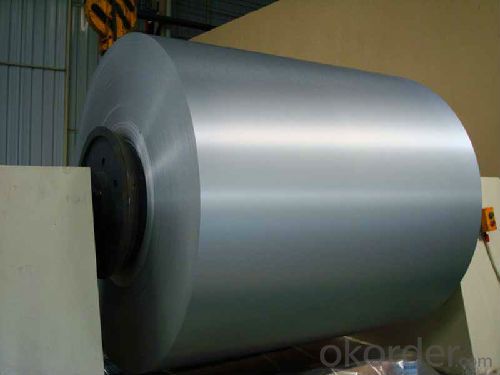
- Q: Can aluminum coils be used in refrigeration systems?
- Yes, aluminum coils can be used in refrigeration systems. Aluminum is a common material choice for evaporator coils in refrigeration systems due to its excellent heat transfer properties, corrosion resistance, and lightweight nature.
- Q: What are the different types of surface finishes for decorative purposes?
- There are several different types of surface finishes that are commonly used for decorative purposes. These finishes can enhance the appearance of a surface, adding texture, depth, and visual interest. Some of the most popular types of surface finishes for decorative purposes include: 1. Polished: Polished finishes are smooth and shiny, creating a reflective surface. This finish is achieved by polishing the surface using abrasive materials, resulting in a glossy appearance. 2. Matte: Matte finishes have a flat, non-reflective surface. They are achieved by using sandpaper or other materials to create a smooth but dull appearance. Matte finishes are often used to create a more subtle and understated aesthetic. 3. Brushed: Brushed finishes have a distinctive linear pattern that is created by brushing the surface with a wire brush or abrasive material. This finish is commonly used on metals, such as stainless steel, to create a textured and visually interesting look. 4. Textured: Textured finishes involve adding patterns or designs to the surface through various techniques. This can include embossing, engraving, or applying a textured coating. Textured finishes can add depth and dimension to a surface, creating a unique and visually appealing effect. 5. Antiqued: Antiqued finishes are designed to mimic the appearance of aged or weathered surfaces. This can be achieved through techniques such as distressing, staining, or adding a patina. Antiqued finishes are often used to create a vintage or rustic look. 6. Metallic: Metallic finishes use metallic pigments or coatings to create a shiny and reflective appearance. This finish can add a touch of elegance and sophistication to a surface, making it a popular choice for decorative purposes. 7. High gloss: High gloss finishes have an extremely smooth and reflective surface, creating a mirror-like effect. This finish is achieved by applying multiple layers of clear coat or lacquer and polishing the surface to a high shine. High gloss finishes are often used to create a modern and luxurious look. Overall, the choice of surface finish for decorative purposes depends on the desired aesthetic and the type of material being used. Each finish has its own unique qualities and can greatly enhance the overall visual appeal of a surface.
- Q: What are the different alloys used for aluminum coils?
- There are several different alloys used for aluminum coils, including 1100, 3003, 5052, and 6061. Each alloy has its own unique properties and characteristics, making them suitable for various applications. For example, 1100 is often used for chemical and food processing equipment, while 3003 is commonly used in heat exchangers and cooking utensils. 5052 is known for its high corrosion resistance and is often used in marine and transportation industries. Lastly, 6061 is a versatile alloy used in structural components, aerospace applications, and automotive parts.
- Q: What are the different packaging options available for aluminum coils?
- The different packaging options available for aluminum coils include wooden crates, cardboard boxes, steel frames, and plastic wrapping.
- Q: How are aluminum coils protected against scratches and damage?
- Aluminum coils are protected against scratches and damage through several methods. One common method is the application of a protective coating or film on the surface of the coil. This coating serves as a barrier between the coil and any potential sources of damage, such as abrasion or impact. Another way to protect aluminum coils is by using a process called coil coating. In this process, the coil is cleaned, pre-treated, and coated with a layer of protective paint or resin. This coating not only enhances the appearance of the coil but also provides a protective layer against scratches and other forms of damage. Additionally, during the manufacturing and handling process, aluminum coils are often wrapped or packaged in materials that provide cushioning and protection. This helps to prevent any scratches or dents that may occur during transportation or storage. Lastly, proper handling and storage practices play a crucial role in protecting aluminum coils against scratches and damage. It is important to handle the coils with care, using appropriate equipment and techniques to minimize the risk of scratching or other forms of damage. Storing the coils in a clean and dry environment can also help prevent any potential damage. Overall, a combination of protective coatings, coil coating processes, proper handling, and storage practices ensures that aluminum coils are well-protected against scratches and damage, maintaining their quality and appearance.
- Q: Are aluminum coils suitable for roofing?
- Yes, aluminum coils are suitable for roofing. Aluminum is a lightweight and durable material that is resistant to corrosion, making it an excellent choice for roofing applications. It is also highly reflective, which can help to reduce energy costs by keeping the building cooler. Additionally, aluminum coils are easy to install and maintain, making them a popular option for both residential and commercial roofing projects.
- Q: How are aluminum coils installed in various applications?
- Aluminum coils are typically installed in various applications by following a few general steps. First, the area where the coil will be installed is prepared by ensuring it is clean and free from any debris. Then, the coil is carefully unrolled or unfolded, depending on its form, and positioned in the desired location. Next, the coil is securely attached or fastened using appropriate methods such as screws, nails, adhesive, or brackets, depending on the specific application. It is important to ensure that the coil is properly aligned and securely fixed to prevent any movement or damage. Finally, any necessary finishing touches, such as sealing or insulating, may be applied to ensure optimal performance and longevity of the aluminum coil in its respective application.
- Q: Are aluminum coils suitable for fire-resistant applications?
- No, aluminum coils are not suitable for fire-resistant applications as aluminum has a low melting point and can easily catch fire or melt in high-temperature environments.
- Q: Can aluminum coils be used for heat exchangers?
- Yes, aluminum coils can be used for heat exchangers. Aluminum is a popular choice for heat exchangers due to its excellent thermal conductivity, lightweight nature, and corrosion resistance. These coils are typically used in applications where heat transfer is required, such as in HVAC systems, refrigeration units, and automotive radiators. The high thermal conductivity of aluminum allows for efficient heat transfer, while its corrosion resistance ensures durability and a longer lifespan for the heat exchanger. Additionally, aluminum coils can be easily formed into various shapes and sizes, making them versatile for different heat exchanger designs.
- Q: I have a 1994 Impala SS with a 5.7L lt1 engine with cast iron heads. Which is better in horsepower gain? Aluminum heads or cast iron heads? People say cast iron heads downsize the hp from 300 to 260 hp. Also which of the two heads are more durable and less restrictive?
- only difference is weight and aluminum is easier to repair
Send your message to us
HVAC Coating Series 1,3,5 Aluminum Coil Mill Finished
- Loading Port:
- Shanghai
- Payment Terms:
- TT or LC
- Min Order Qty:
- 5 m.t.
- Supply Capability:
- 9000 m.t./month
OKorder Service Pledge
OKorder Financial Service
Similar products
Hot products
Hot Searches
Related keywords













